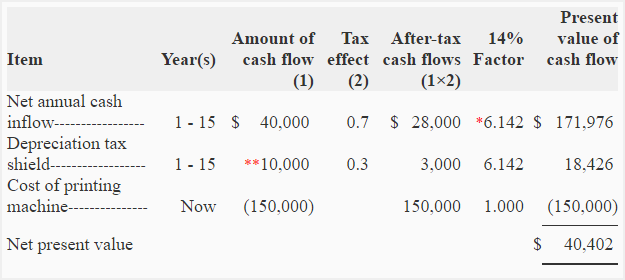Exercise-17: After-tax cash flows in net present value (NPV) analysis
Learning objective:
This exercise illustrates the consideration of tax effects on cash flows and tax deductible non-cash expenses (like depreciation) while conducting a project’s net present value (NPV) analysis.
Falcon Company is considering to purchase a printing machine. The relevant information is given below:
- Cost of the printing machine: $150,000
- Annual cash inflows: $45,000
- Useful life of printing machine: 15 years
- Salvage value (Residual value) after 15-year period: $10,000
- Annual cash expenses: $5,000
Falcon company uses straight line method of depreciation. Salvage value is not taken into account for calculating depreciation for tax purposes. The tax rate of Falcon is 30% and the company requires a 14% after-tax return on all investments.
Required: Compute net present value (NPV) of the proposed printing machine.
Solution:
Let’s solve the exercise in three steps.
Step 1 – Calculate net annual cash inflows:
Net annual cash inflow = Annual cash inflow – Annual cash expenses
= $45,000 – $5,000
= $40,000
Step 2 – Calculate the net present value:

*Value from “present value of an annuity of $1 in arrears table“:
14% interest rate, 15 periods.
**Tax savings from depreciation tax shield – depreciation is a tax deductible non-cash expense.
NPV decision
The printing machine has a positive net present value (NPV) of $40,402 which makes it an acceptable investment.

Leave a comment